
A more recent article on heart failure is available.
Am Fam Physician. 2017;96(9):582-588
Author disclosure: No relevant financial affiliations.
Heart failure with preserved ejection fraction, also referred to as diastolic heart failure, causes almost one-half of the 5 million cases of heart failure in the United States. It is more common among older patients and women, and results from abnormalities of active ventricular relaxation and passive ventricular compliance, leading to a decline in stroke volume and cardiac output. Heart failure with preserved ejection fraction should be suspected in patients with typical symptoms (e.g., fatigue, weakness, dyspnea, orthopnea, paroxysmal nocturnal dyspnea, edema) and signs (S3 heart sound, displaced apical pulse, and jugular venous distension) of chronic heart failure. Echocardiographic findings of normal ejection fraction with impaired diastolic function confirm the diagnosis. Measurement of natriuretic peptides is useful in the evaluation of patients with suspected heart failure with preserved ejection fraction in the ambulatory setting. Multiple trials have not found medications to be an effective treatment, except for diuretics. Patients with congestive symptoms should be treated with a diuretic. If hypertension is present, it should be treated according to evidence-based guidelines. Exercise and treatment by multidisciplinary teams may be helpful. Atrial fibrillation should be treated using a rate-control strategy and appropriate anticoagulation. Revascularization should be considered for patients with heart failure with preserved ejection fraction and coronary artery disease. The prognosis is comparable to that of heart failure with reduced ejection fraction and is worsened by higher levels of brain natriuretic peptide, older age, a history of myocardial infarction, and reduced diastolic function.
Heart failure with preserved ejection fraction (HFpEF), also referred to as diastolic heart failure, is characterized by signs and symptoms of heart failure and a left ventricular ejection fraction (LVEF) greater than 50%. Heart failure associated with intermediate reductions in LVEF (40% to 49%) is also commonly grouped into this category.
WHAT IS NEW ON THIS TOPIC: HEART FAILURE WITH PRESERVED EJECTION FRACTION
A systematic review found that jugular venous distention, an S3 heart sound, and displaced apical impulse significantly increased the likelihood of heart failure.
In the absence of hypertension, evidence does not support treating heart failure with preserved ejection fraction with any medication except diuretics. Additionally, trials of angiotensin receptor blockers, digoxin, nitrates, and spironolactone raised concerns about adverse effects.
| Clinical recommendation | Evidence rating | References |
|---|---|---|
| Physicians should obtain a brain natriuretic peptide or N-terminal pro–brain natriuretic peptide level for patients with possible heart failure if the diagnosis is uncertain. | C | 3, 5–7, 9, 13 |
| Patients with suspected heart failure should be referred for two-dimensional transthoracic echocardiography to confirm the diagnosis and identify preserved or reduced ejection fraction. This includes those with elevated brain natriuretic peptide levels or physical examination findings suggestive of heart failure, and those who meet the Framingham, MICE (Male, Infarction, Crepitations, Edema), or Netherlands criteria for heart failure. | C | 3, 5, 10, 11, 13 |
| Patients with HFpEF who have signs and symptoms of fluid overload should be treated with diuretics. | B | 3, 5, 31 |
| Patients with HFpEF should be referred for endurance and resistance training. | B | 3, 5, 29 |
| Patients with HFpEF and coronary artery disease who have indications should be offered revascularization. | C | 3, 5, 30 |
| Hypertension in patients with HFpEF should be treated according to evidence-based hypertension treatment guidelines. | C | 3 |
| The use of nitrates, spironolactone, and angiotensin receptor blockers should be avoided in patients with HFpEF. Digoxin should also be avoided in patients 65 years and older who have HFpEF. | B | 18, 23, 25, 27 |
Pathophysiology
The pathogenesis of diastolic dysfunction involves abnormalities of active ventricular relaxation and passive ventricular compliance, which lead to ventricular stiffness and higher diastolic pressures.1 These pressures are transmitted through atrial and pulmonary venous systems, reducing lung compliance. A combination of decreased lung compliance and cardiac output leads to symptoms. Physiologic stressors, such as a hypertensive crisis, can overcome compensatory mechanisms and result in pulmonary edema.2
Epidemiology
Approximately 5 million persons in the United States have been diagnosed with heart failure, with an incidence of more than 650,000 new diagnoses per year.3 Almost one-half of patients with heart failure have preserved ejection fraction. Risk factors include older age, female sex, obesity, hypertension, tobacco use, diabetes mellitus, coronary artery disease (CAD), valvular heart disease, and atrial fibrillation.4 In 2013, health care expenditures directly attributed to heart failure totaled approximately $30 billion.3
Diagnosis
The diagnosis of HFpEF requires clinical symptoms and/or signs of heart failure, as well as evidence of preserved LVEF and diastolic dysfunction.5 Hypertension, CAD, and valvular disease are the most common causes.4 Identification of other underlying causes may lead to treatment that can optimize outcomes (Table 1).3–5 The first step in the diagnosis of HFpEF is recognition of possible heart failure and subsequent referral for two-dimensional transthoracic echocardiography (TTE) to confirm the diagnosis.
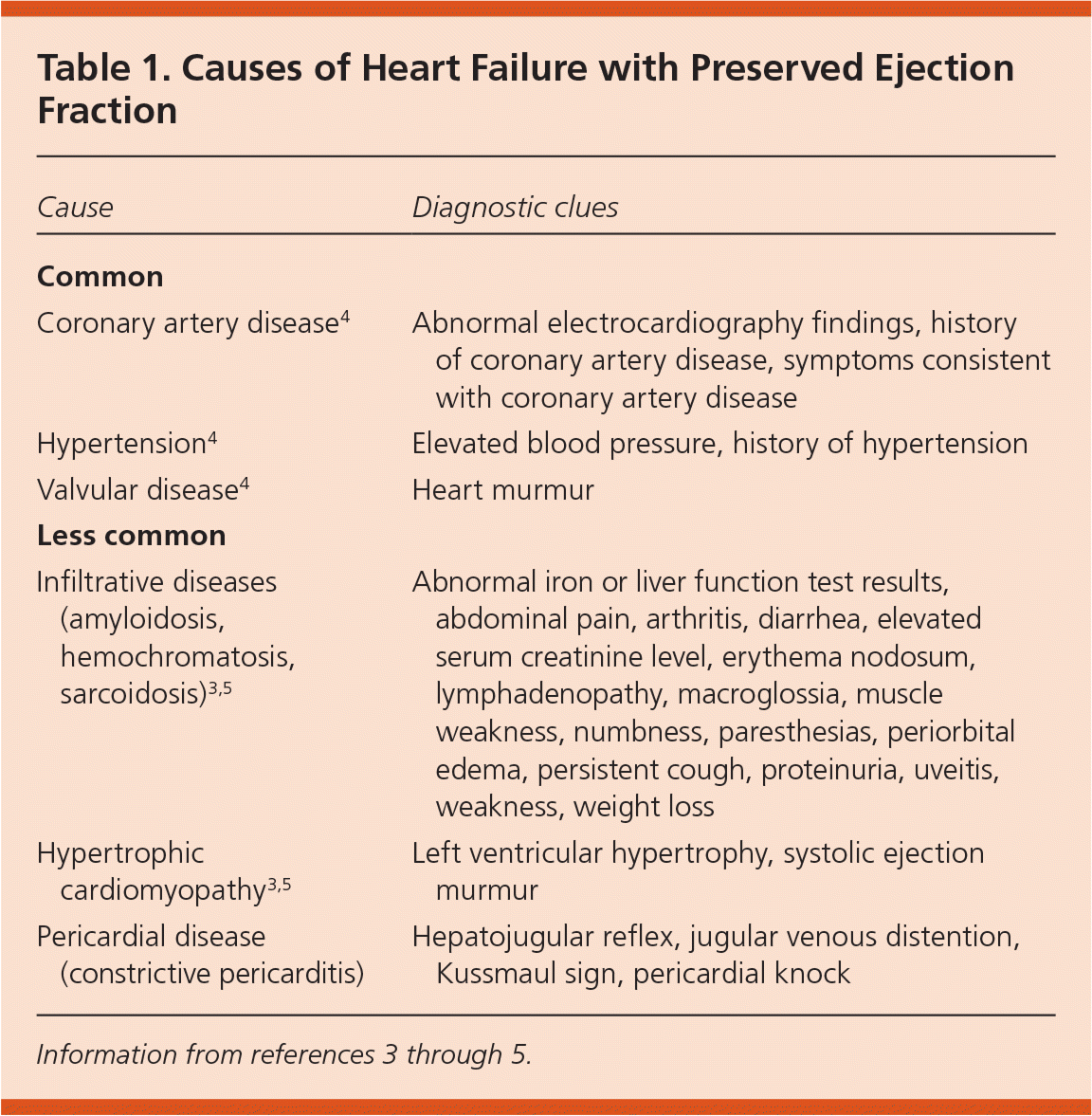
| Cause | Diagnostic clues |
|---|---|
| Common | |
| Coronary artery disease4 | Abnormal electrocardiography findings, history of coronary artery disease, symptoms consistent with coronary artery disease |
| Hypertension4 | Elevated blood pressure, history of hypertension |
| Valvular disease4 | Heart murmur |
| Less common | |
| Infiltrative diseases (amyloidosis, hemochromatosis, sarcoidosis)3,5 | Abnormal iron or liver function test results, abdominal pain, arthritis, diarrhea, elevated serum creatinine level, erythema nodosum, lymphadenopathy, macroglossia, muscle weakness, numbness, paresthesias, periorbital edema, persistent cough, proteinuria, uveitis, weakness, weight loss |
| Hypertrophic cardiomyopathy 3,5 | Left ventricular hypertrophy, systolic ejection murmur |
| Pericardial disease (constrictive pericarditis) | Hepatojugular reflex, jugular venous distention, Kussmaul sign, pericardial knock |
SIGNS AND SYMPTOMS
Common symptoms of HFpEF include fatigue, weakness, dyspnea, orthopnea, paroxysmal nocturnal dyspnea, and edema. A systematic review found that jugular venous distention (positive likelihood ratio [LR+] = 4.4, negative likelihood ratio [LR–] = 0.88), an S3 heart sound (LR+ = 7.4, LR– = 0.92), and displaced apical impulse (LR+ = 16, LR– = 0.58) significantly increased the likelihood of heart failure.6 Two reviews showed that the absence of historical or physical examination findings was not useful in excluding heart failure (LR – = 0.31 to 0.98).6,7
DIAGNOSTIC TESTS
Guidelines from the American College of Cardiology/American Heart Association (ACC/AHA) and European Society of Cardiology (ESC) recommend the use of natriuretic peptides for assessment of patients with symptoms of heart failure.3,5 A brain natriuretic peptide (BNP) level less than 100 pg per mL (100 ng per L) or N-terminal pro-BNP (NT pro-BNP) level less than 300 pg per mL (300 ng per L) can reliably rule out acute heart failure in the emergency department setting (LR – = 0.1).8
Because the spectrum of illness is different and often milder in the primary care setting, lower cutoffs are needed to rule out HFpEF. The ESC guidelines recommend cutoffs of 35 pg per mL (35 ng per L) for BNP and 125 pg per mL (125 ng per L) for NT pro-BNP.5 Three systematic reviews of primary care studies showed that normal BNP and NT pro-BNP levels were useful for excluding heart failure in low-risk patients, but they were not useful for confirming the diagnosis6,7,9 (Table 26,7 ).
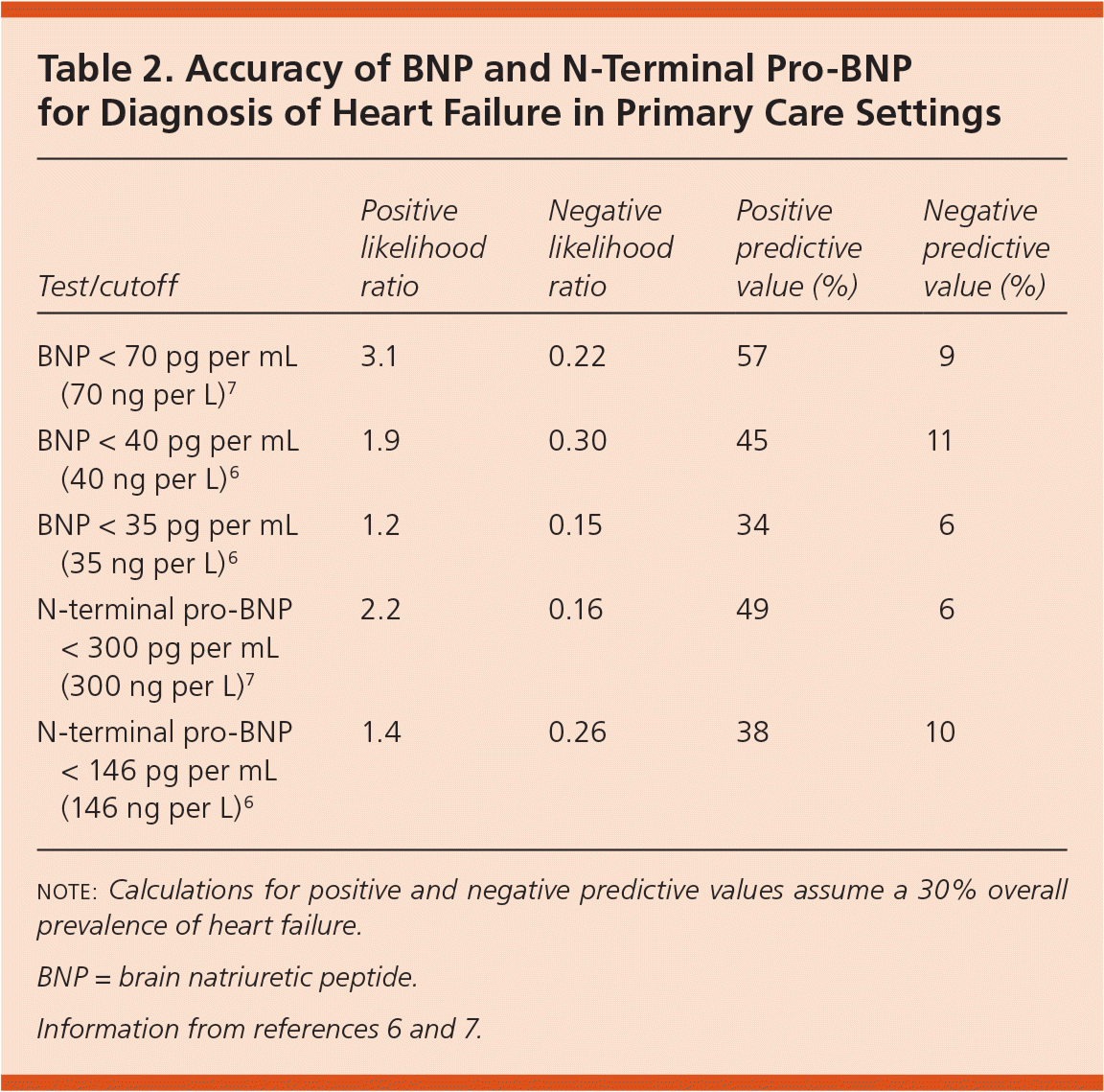
| Test/cutoff | Positive likelihood ratio | Negative likelihood ratio | Positive predictive value (%) | Negative predictive value (%) |
|---|---|---|---|---|
| BNP < 70 pg per mL (70 ng per L)7 | 3.1 | 0.22 | 57 | 9 |
| BNP < 40 pg per mL (40 ng per L)6 | 1.9 | 0.30 | 45 | 11 |
| BNP < 35 pg per mL (35 ng per L)6 | 1.2 | 0.15 | 34 | 6 |
| N-terminal pro-BNP < 300 pg per mL (300 ng per L) 7 | 2.2 | 0.16 | 49 | 6 |
| N-terminal pro-BNP < 146 pg per mL (146 ng per L)6 | 1.4 | 0.26 | 38 | 10 |
A systematic review found that normal electrocardiography findings reduced the likelihood of heart failure (pooled LR– = 0.19).7 However, normal chest radiography was less helpful for excluding heart failure (LR – = 0.38), and moderately helpful for confirming it (LR+ = 4.1).7 Neither electrocardiography nor chest radiography significantly improved the accuracy of diagnostic models when natriuretic peptide results were available.9,10 Nonetheless, electrocardiography is necessary in patients with suspected heart failure to assess for evidence of CAD, left ventricular hypertrophy, and dysrhythmia.3,5
DIAGNOSTIC CRITERIA
A large, prospective, primary care–based study compared seven sets of diagnostic criteria in patients who had heart failure with preserved or reduced ejection fraction.11 It showed that most criteria had LRs+ that increased the likelihood of diagnosing heart failure, but none reliably excluded it. The Framingham criteria were helpful for ruling in heart failure (Table 3).12
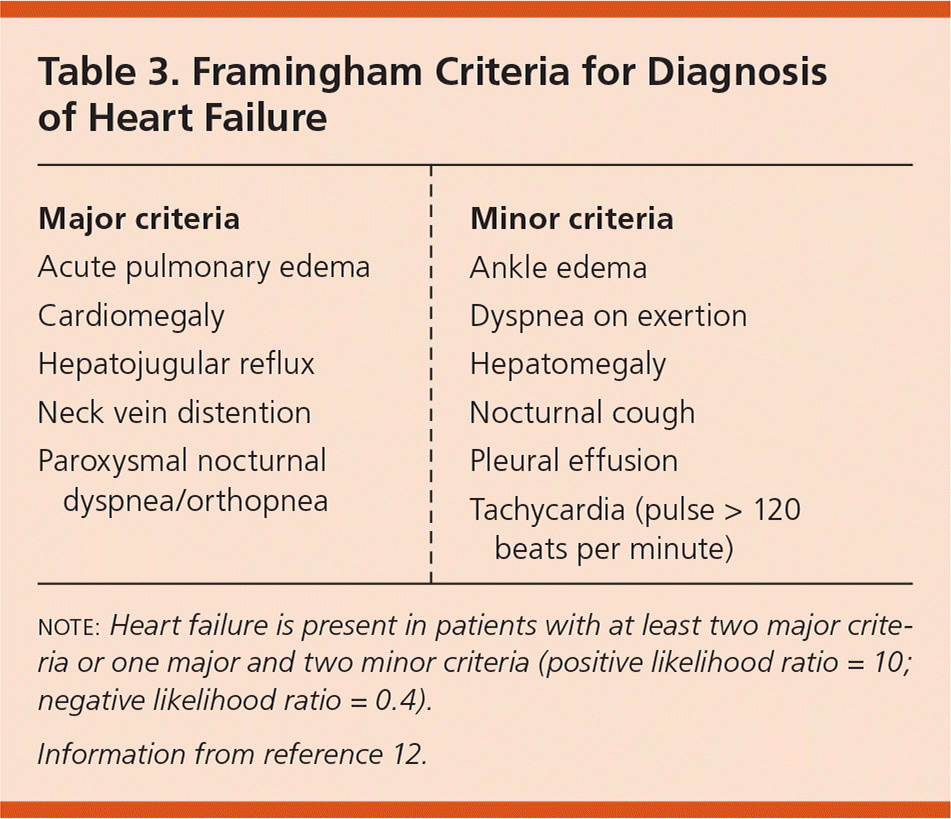
| Major criteria |
| Acute pulmonary edema |
| Cardiomegaly |
| Hepatojugular reflux |
| Neck vein distention |
| Paroxysmal nocturnal dyspnea/orthopnea |
| Minor criteria |
| Ankle edema |
| Dyspnea on exertion |
| Hepatomegaly |
| Nocturnal cough |
| Pleural effusion |
| Tachycardia (pulse > 120 beats per minute) |
Two diagnostic rules were developed using data from primary care settings that included patients with heart failure with preserved or reduced ejection fraction. The Male, Infarction, Crepitations, Edema (MICE) diagnostic rule was derived from one data set and validated in four other data sets.10 It has excellent accuracy, with an area under the receiver operating characteristic curve of 0.9. The MICE rule states that in patients with suspected heart failure, echocardiography is recommended for those with a history of myocardial infarction and basilar lung crackles, or in any male with ankle edema. Other patients should undergo echocardiography if the BNP level is greater than 35 pg per mL or if the NT pro-BNP level is greater than 125 pg per mL.
Investigators from the Netherlands prospectively evaluated 721 patients with suspected heart failure who were referred by family physicians to specialized diagnostic clinics.13 They derived a diagnostic rule that was validated using different data sets and found to have excellent accuracy, with an area under the receiver operating characteristic curve of 0.85. Using a combination of clinical findings and BNP, a score less than 13 excludes heart failure in a primary care setting.
CARDIAC IMAGING
TTE is the preferred test to confirm HFpEF. TTE should include an assessment of LVEF, left ventricular mass, the presence of valvular disease, and abnormal left atrial size. The combined finding of normal left ventricular systolic function and diastolic dysfunction confirms HFpEF.14,15 Transesophageal echocardiography is not recommended for routine evaluation of HFpEF.5
SUGGESTED APPROACH TO DIAGNOSIS
Patients presenting with symptoms concerning for heart failure should undergo clinical evaluation. If physical examination findings suggest heart failure (jugular venous distention, S3 heart sound, or displaced apical impulse) or fulfill the clinical criteria for the MICE or Framingham rules, the patient should be referred for TTE.3,5 BNP or NT pro-BNP should be measured in patients who do not meet these criteria, and the patient should be referred for TTE if the BNP level is 35 pg per mL or greater, the NT pro-BNP level is 125 pg per mL or greater, or the score on the Netherlands rule is 13 or greater. TTE assessment of LVEF and diastolic function can confirm HFpEF5 (Figure 1).
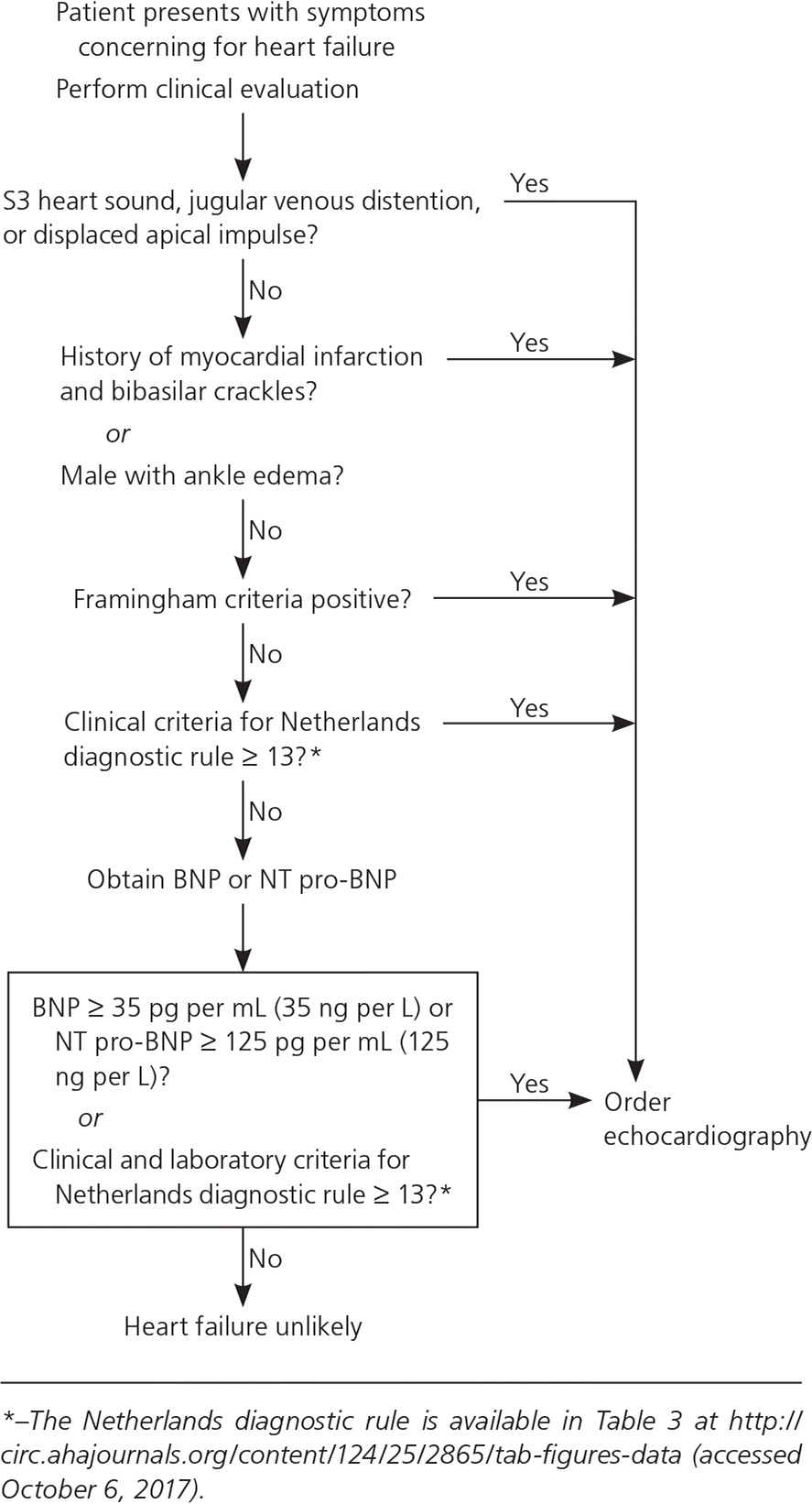
Treatment
GUIDELINE RECOMMENDATIONS
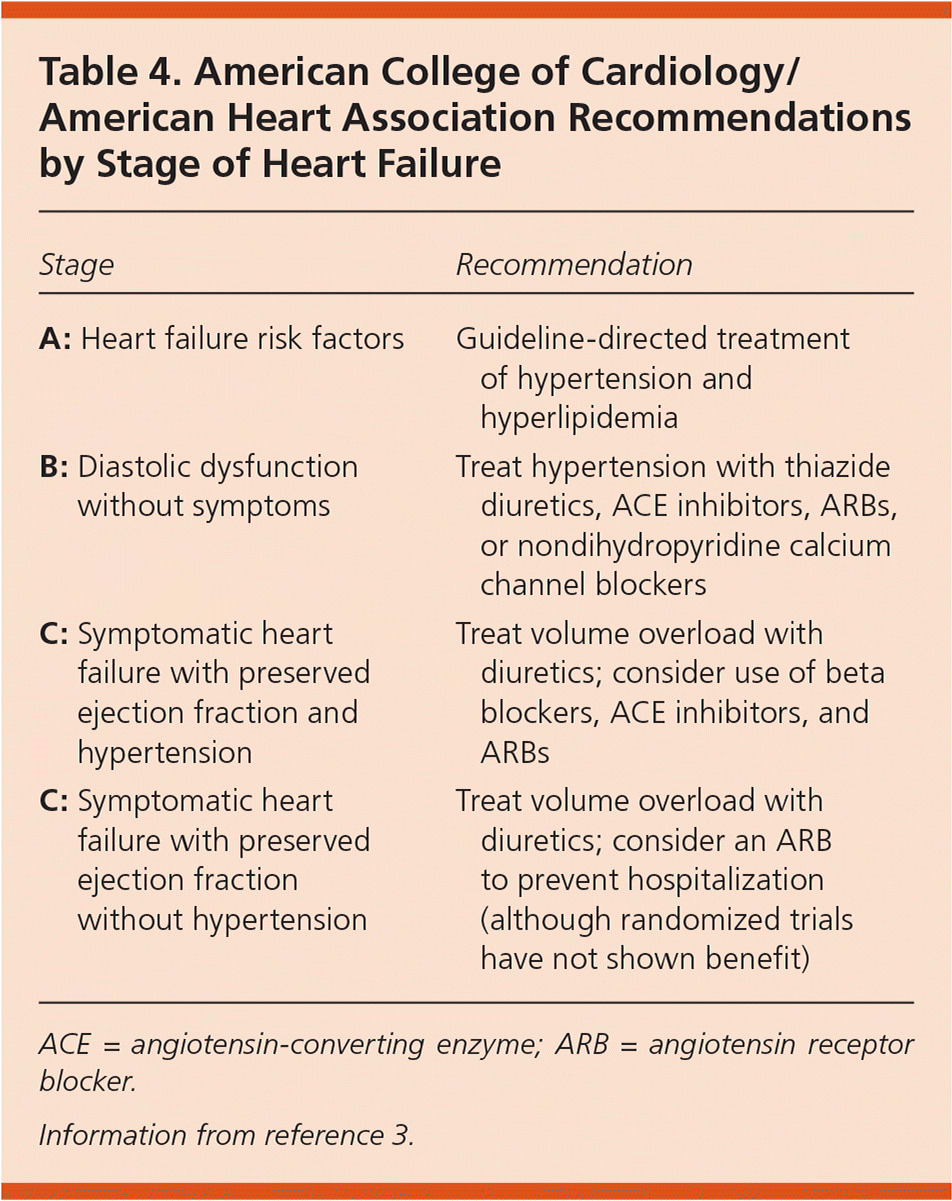
| Stage | Recommendation |
|---|---|
| A: Heart failure risk factors | Guideline-directed treatment of hypertension and hyperlipidemia |
| B: Diastolic dysfunction without symptoms | Treat hypertension with thiazide diuretics, ACE inhibitors, or nondihydropyridine calcium channel blockers |
| C: Symptomatic heart failure with preserved ejection fraction and hypertension | Treat volume overload with diuretics; consider use of beta blockers, ACE inhibitors |
| C: Symptomatic heart failure with preserved ejection fraction without hypertension | Treat volume overload with diuretics |
The ESC recommends diuretics for treating fluid overload in patients with HFpEF.5 However, it makes no recommendation regarding other medications for treatment. It recommends identifying and treating cardiovascular and noncardiovascular comorbidities, because most deaths and hospitalizations in patients with HFpEF are not due to chronic heart failure.
DATA FROM CLINICAL TRIALS
Angiotensin-Converting Enzyme Inhibitors and Angiotensin Receptor Blockers. RCTs have investigated the effectiveness of several medication classes in patients with HFpEF (eTable A). Two large trials examining candesartan (Atacand) and irbesartan (Avapro) failed to show reductions in mortality or all-cause hospitalization.16,17 A Cochrane meta-analysis found no difference in total hospitalizations or mortality in patients treated with an angiotensin receptor blocker, and noted an increased rate of adverse events (number need to harm = 33).18 A trial comparing perindopril (Aceon) with placebo showed no difference in all-cause mortality, heart failure hospitalization, or all-cause hospitalization at 2.1 years.19
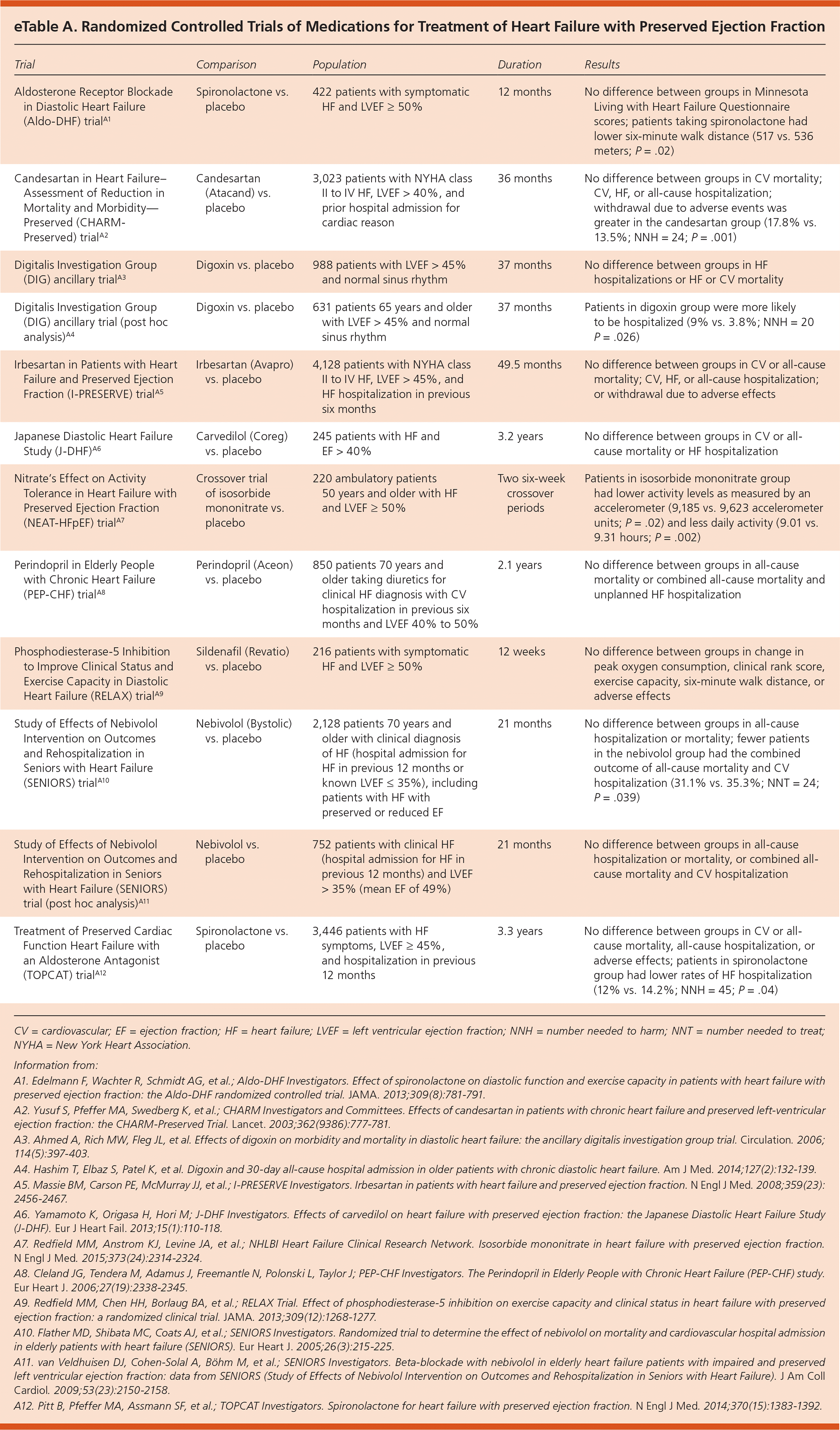
| Trial | Comparison | Population | Duration | Results |
|---|---|---|---|---|
| Aldosterone Receptor Blockade in Diastolic Heart Failure (Aldo-DHF) trialA1 | Spironolactone vs. placebo | 422 patients with symptomatic HF and LVEF ≥ 50% | 12 months | No difference between groups in Minnesota Living with Heart Failure Questionnaire scores; patients taking spironolactone had lower six-minute walk distance (517 vs. 536 meters; P = .02) |
| Candesartan in Heart Failure–Assessment of Reduction in Mortality and Morbidity—Preserved (CHARM-Preserved) trialA2 | Candesartan (Atacand) vs. placebo | 3,023 patients with NYHA class II to IV HF, LVEF > 40%, and prior hospital admission for cardiac reason | 36 months | No difference between groups in CV mortality; CV, HF, or all-cause hospitalization; withdrawal due to adverse events was greater in the candesartan group (17.8% vs. 13.5%; NNH = 24; P = .001) |
| Digitalis Investigation Group (DIG) ancillary trialA3 | Digoxin vs. placebo | 988 patients with LVEF > 45% and normal sinus rhythm | 37 months | No difference between groups in HF hospitalizations or HF or CV mortality |
| Digitalis Investigation Group (DIG) ancillary trial (post hoc analysis)A4 | Digoxin vs. placebo | 631 patients 65 years and older with LVEF > 45% and normal sinus rhythm | 37 months | Patients in digoxin group were more likely to be hospitalized (9% vs. 3.8%; NNH = 20; P = .026) |
| Irbesartan in Patients with Heart Failure and Preserved Ejection Fraction (I-PRESERVE) trialA5 | Irbesartan (Avapro) vs. placebo | 4,128 patients with NYHA class II to IV HF, LVEF > 45%, and HF hospitalization in previous six months | 49.5 months | No difference between groups in CV or all-cause mortality; CV, HF, or all-cause hospitalization; or withdrawal due to adverse effects |
| Japanese Diastolic Heart Failure Study (J-DHF)A6 | Carvedilol (Coreg) vs. placebo | 245 patients with HF and EF > 40% | 3.2 years | No difference between groups in CV or all-cause mortality or HF hospitalization |
| Nitrate's Effect on Activity Tolerance in Heart Failure with Preserved Ejection Fraction (NEAT-HFpEF) trialA7 | Crossover trial of isosorbide mononitrate vs. placebo | 220 ambulatory patients 50 years and older with HF and LVEF ≥ 50% | Two six-week crossover periods | Patients in isosorbide mononitrate group had lower activity levels as measured by anaccelerometer (9,185 vs. 9,623 accelerometer units; P = .02) and less daily activity (9.01 vs. 9.31 hours; P = .002) |
| Perindopril in Elderly People with Chronic Heart Failure (PEP-CHF) trialA8 | Perindopril (Aceon) vs. placebo | 850 patients 70 years and older taking diuretics for clinical HF diagnosis with CV hospitalization in previous six months and LVEF 40% to 50% | 2.1 years | No difference between groups in all-cause mortality or combined all-cause mortality and unplanned HF hospitalization |
| Phosphodiesterase-5 Inhibition to Improve Clinical Status and Exercise Capacity in Diastolic Heart Failure (RELAX) trialA9 | Sildenafil (Revatio) vs. placebo | 216 patients with symptomatic HF and LVEF ≥ 50% | 12 weeks | No difference between groups in change in peak oxygen consumption, clinical rank score, exercise capacity, six-minute walk distance, or adverse effects |
| Study of Effects of Nebivolol Intervention on Outcomes and Rehospitalization in Seniors with Heart Failure (SENIORS) trialA10 | Nebivolol (Bystolic) vs. placebo | 2,128 patients 70 years and older with clinical diagnosis of HF (hospital admission for HF in previous 12 months or known LVEF ≤ 35%), including patients with HF with preserved or reduced EF | 21 months | No difference between groups in all-cause hospitalization or mortality; fewer patients in the nebivolol group had the combined outcome of all-cause mortality and CV hospitalization (31.1% vs. 35.3%; NNT = 24; P = .039) |
| Study of Effects of Nebivolol Intervention on Outcomes and Rehospitalization in Seniors with Heart Failure (SENIORS) trial (post hoc analysis)A11 | Nebivolol vs. placebo | 752 patients with clinical HF (hospital admission for HF in previous 12 months) and LVEF > 35% (mean EF of 49%) | 21 months | No difference between groups in all-cause hospitalization or mortality, or combined all-cause mortality and CV hospitalization |
| Treatment of Preserved Cardiac Function Heart Failure with an Aldosterone Antagonist (TOPCAT) trialA12 | Spironolactone vs. placebo | 3,446 patients with HF symptoms, LVEF ≥ 45%, and hospitalization in previous 12 months | 3.3 years | No difference between groups in CV or all-cause mortality, all-cause hospitalization, or adverse effects; patients in spironolactone group had lower rates of HF hospitalization (12% vs. 14.2%; NNH = 45; P = .04) |
Beta Blockers. An RCT of nebivolol (Bystolic) in patients 70 years and older who had heart failure with preserved or reduced ejection fraction showed no difference in all-cause mortality or all-cause hospitalization.20 There was no difference in any outcome among the 752 patients with HFpEF who underwent randomization.21 A smaller study of carvedilol (Coreg) found no difference in mortality or heart failure hospitalization.22
Other Drugs. A one-year RCT of spironolactone showed a reduced six-minute walk distance in the treatment group compared with those who received placebo (P = .02).23 However, a larger trial found no difference in all-cause hospitalizations.24 A randomized crossover trial of isosorbide mononitrate found that patients randomized to isosorbide mononitrate had lower activity levels and fewer minutes of daily physical activity.25 An RCT of digoxin showed no difference in all-cause or heart failure hospitalization, or in heart failure mortality.26 A post hoc analysis of this study in patients older than 65 years found a higher rate of all-cause hospitalization in the 30 days after randomization in patients who received digoxin (number needed to harm = 20; P = .026).27 An RCT of sildenafil (Revatio) found no difference in exercise capacity or clinical status in patients with HFpEF.28
Nonmedical Therapy. A meta-analysis of five RCTs of exercise training found that it improved exercise capacity (P < .0001), mean six-minute walking distance (P = .022), and quality of life.29
TREATMENT OF COMORBID ATRIAL FIBRILLATION AND CAD
Atrial fibrillation is common in patients with HFpEF. The ACC/AHA and ESC guidelines recommend treatment of atrial fibrillation in these patients.3,5 Management includes identification and treatment of underlying causes (e.g., thyrotoxicosis), anticoagulation guided by appropriate risk stratification, and rate-control strategies using beta blockers, calcium channel blockers, and digoxin. No evidence supports a rhythm-control strategy unless rate control does not control symptoms.3,5 Complete revascularization is associated with improved mortality in patients with HFpEF and CAD who meet criteria for revascularization.3,30
ACUTE HEART FAILURE
Hospitalized patients with HFpEF should be treated similarly to those with heart failure with reduced ejection fraction (diuretics and supportive measures). Family physicians caring for patients with HFpEF should consider using a multidisciplinary team for follow-up and care coordination, an approach shown to decrease mortality and hospitalizations in patients with heart failure and reduced ejection fraction.3 No evidence supports the use of intensive interventions (e.g., inotropic support, cardiac resynchronization therapy).3,5
SUMMARY OF TREATMENT RECOMMENDATIONS
Patients with HFpEF and symptoms of volume overload should be treated with diuretics.31 Hypertension should be treated according to appropriate guidelines.3 Although RCTs of several medications showed fewer heart failure hospitalizations, this benefit was offset by increases in hospitalizations for other reasons. Thus, in the absence of hypertension, the evidence does not support treating patients with HFpEF with any medication except diuretics. Additionally, RCTs of angioten-sin receptor blockers, nitrates, and spironolactone raise concerns about adverse effects, and physicians should avoid using these medications, if possible.18,23–25 Similarly, physicians should avoid the use of digoxin in patients 65 years and older.27 Physicians should consider referring patients with HFpEF who can exercise safely for exercise training or cardiac rehabilitation. Comorbid atrial fibrillation or CAD should be treated.
Prognosis
Diastolic dysfunction of any severity is associated with increased mortality, even in asymptomatic patients. One population-based study found that after four years, 3.3% of patients with diastolic dysfunction on baseline echocardiography developed symptomatic heart failure, 23% had worsened diastolic dysfunction, and 9% had improved diastolic dysfunction.32 Over the subsequent six years of follow-up, 3% of patients with normalized diastolic dysfunction, 8% with mild diastolic dysfunction, and 12% of those with moderate to severe diastolic dysfunction developed clinical heart failure. Older age, hypertension, diabetes, and CAD increased the risk of heart failure.
Prognosis after the first hospitalization for HFpEF is poor, with one-year mortality rates as high as 25% among older patients and five-year mortality rates of 24% among patients older than 60 years and 54% among those older than 80 years.33,34 Patients with HFpEF fare worse than age- and sex-matched controls and have reported mortality rates similar to or better than patients with heart failure with reduced ejection fraction.35,36 Factors associated with worse prognosis include higher levels of NT pro-BNP, older age, diabetes, history of myocardial infarction or chronic obstructive pulmonary disease, reduced glomerular filtration rate and diastolic function, and right ventricular remodeling.36–38
Data Sources: We searched the Cochrane Database of Systematic Reviews, evidence-based guidelines from the National Guideline Clearinghouse, the Institute for Clinical Systems Improvement, the Database of Abstracts of Reviews of Effects, Essential Evidence Plus, and Dynamed using the term diastolic heart failure. We searched Ovid Medline using the search terms diastolic heart failure, diagnosis, prognosis, and controlled clinical trials. Search date: October 2016.
